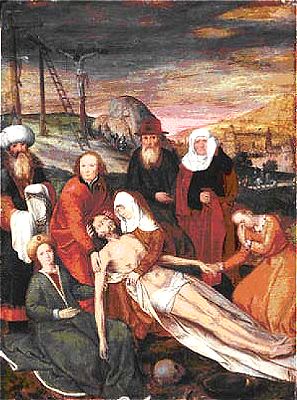 |
|
THE LAMENTATION
SN 205, oil on panel, mid-16th c
Marcellus Coffermans
Early Netherlandish, active from1549, died after 1570
From: "The Pages"
ARTIST:
It is known he was a painter in Antwerp who was a member of the Lukasguild in 1549 and
1554; his dated pictures are found from 1561 to 1570. Aside from that, most of the
information on Coffermans falls into the “maybe” category.
The Dictionary of Art lumps him in with a number of other “Masters” in the
category “Master of the Female Half-lengths.” Altho’ a number of individual
candidates were suggested for that title, that name was finally applied to what was
apparently a large workshop that specialized in small-scale panels of aristocratic ladies
devotional scenes. Some of the painted women are represented with an ointment jar, the
attribute of Mary Magdalene. The D-of-A also suggests that Coffermans may have been one of
the painters in Patinir’s workshop in Antwerp c 1520. |
The “Master” and his workshop also produced replicas of standardized
compositions such as the Crucifixion and the Deposition.
SUBJECT:
Christ has been taken down from the cross; Mary and the other mourners gather beside his
lifeless body in lamentation. In Biblical times, a vivid expression of grief was expected.
Weeping and wailing, throwing dust upon the head, and ripping clothing were outward forms
of mourning. The people of that time would be puzzled by the modern, more sedate forms of
expressing our despair.
PAINTING:
Mary, holding Christ’s dead body, is surrounded by mourners. Mary Magdalene is on the
left in green; she holds her attribute, the jar of ointment. St John wears red; there are
four others. The background includes the hill of Golgotha with the other two crosses,
still occupied.
Prominent in the foreground is the vanitas skull, emblem of man’s fragility and the
finality of death.
HISTORIC CONTEXT:
The Old Testament has many Hebrew words for mourning, ranging from anger to the more
common idea of grief over a death. In those times mourning started the moment a person
died. The family would begin the wailing, and neighbors would rush to the bereaved
household to join in. If the family could afford them, hired mourners were employed to add
their chants. The period for mourning varied. According to one Jewish tradition, mourning
was to take place on the third, seventh and fortieth days, and on the anniversary.
To the Jewish people, crucifixion was the most disgusting form of death. It was the Romans
most severe form of execution, reserved for slaves and criminals. It involved attaching
the victim to the cross with nails through the wrists, and sometimes through the feet. As
the victim dangled, blood could no longer circulate; exhaustion set in, and several days
later, he died. Occasionally, to hasten death, executioners broke the victim’s legs
so he couldn’t support himself. Then the body was left to rot.
Jesus was offered a brew to deaden His senses, but He refused. And in only six hours, He
expired. The disciples secured Pilate’s permission for a decent burial so that his
body was saved. And according to Christian belief, out of the ugliness and agony of
crucifixion, God accomplished the greatest good, the redemption of all sinners. Following
the conversion of Emperor Constantine to Christianity the cross became a sacred symbol and
the Romans abolished that grisly means of death.
ringlingdocents.org
|